Xinke Shen
Dynamic-Attention-based EEG State Transition Modeling for Emotion Recognition
Nov 07, 2024



Abstract:Electroencephalogram (EEG)-based emotion decoding can objectively quantify people's emotional state and has broad application prospects in human-computer interaction and early detection of emotional disorders. Recently emerging deep learning architectures have significantly improved the performance of EEG emotion decoding. However, existing methods still fall short of fully capturing the complex spatiotemporal dynamics of neural signals, which are crucial for representing emotion processing. This study proposes a Dynamic-Attention-based EEG State Transition (DAEST) modeling method to characterize EEG spatiotemporal dynamics. The model extracts spatiotemporal components of EEG that represent multiple parallel neural processes and estimates dynamic attention weights on these components to capture transitions in brain states. The model is optimized within a contrastive learning framework for cross-subject emotion recognition. The proposed method achieved state-of-the-art performance on three publicly available datasets: FACED, SEED, and SEED-V. It achieved 75.4% accuracy in the binary classification of positive and negative emotions and 59.3% in nine-class discrete emotion classification on the FACED dataset, 88.1% in the three-class classification of positive, negative, and neutral emotions on the SEED dataset, and 73.6% in five-class discrete emotion classification on the SEED-V dataset. The learned EEG spatiotemporal patterns and dynamic transition properties offer valuable insights into neural dynamics underlying emotion processing.
A Contrastive Learning Based Convolutional Neural Network for ERP Brain-Computer Interfaces
Jul 02, 2024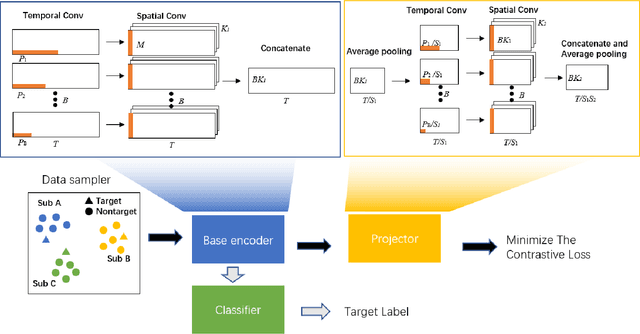
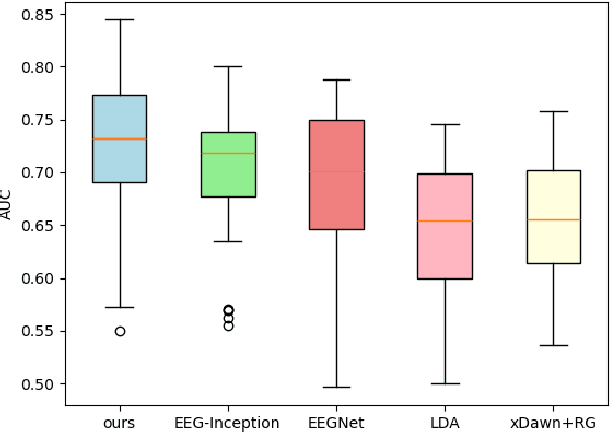
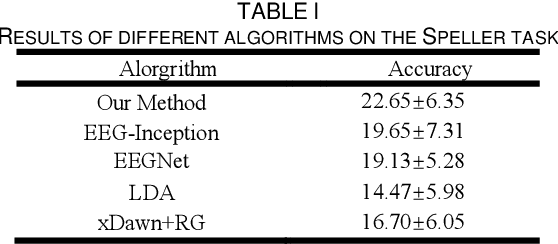
Abstract:ERP-based EEG detection is gaining increasing attention in the field of brain-computer interfaces. However, due to the complexity of ERP signal components, their low signal-to-noise ratio, and significant inter-subject variability, cross-subject ERP signal detection has been challenging. The continuous advancement in deep learning has greatly contributed to addressing this issue. This brief proposes a contrastive learning training framework and an Inception module to extract multi-scale temporal and spatial features, representing the subject-invariant components of ERP signals. Specifically, a base encoder integrated with a linear Inception module and a nonlinear projector is used to project the raw data into latent space. By maximizing signal similarity under different targets, the inter-subject EEG signal differences in latent space are minimized. The extracted spatiotemporal features are then used for ERP target detection. The proposed algorithm achieved the best AUC performance in single-trial binary classification tasks on the P300 dataset and showed significant optimization in speller decoding tasks compared to existing algorithms.
Contrastive Learning of Shared Spatiotemporal EEG Representations Across Individuals for Naturalistic Neuroscience
Feb 22, 2024



Abstract:Neural representations induced by naturalistic stimuli offer insights into how humans respond to peripheral stimuli in daily life. The key to understanding the general neural mechanisms underlying naturalistic stimuli processing involves aligning neural activities across individuals and extracting inter-subject shared neural representations. Targeting the Electroencephalogram (EEG) technique, known for its rich spatial and temporal information, this study presents a general framework for Contrastive Learning of Shared SpatioTemporal EEG Representations across individuals (CL-SSTER). Harnessing the representational capabilities of contrastive learning, CL-SSTER utilizes a neural network to maximize the similarity of EEG representations across individuals for identical stimuli, contrasting with those for varied stimuli. The network employed spatial and temporal convolutions to simultaneously learn the spatial and temporal patterns inherent in EEG. The versatility of CL-SSTER was demonstrated on three EEG datasets, including a synthetic dataset, a speech audio EEG dataset, and an emotional video EEG dataset. CL-SSTER attained the highest inter-subject correlation (ISC) values compared to the state-of-the-art ISC methods. The latent representations generated by CL-SSTER exhibited reliable spatiotemporal EEG patterns, which can be explained by specific aspects of the stimuli. CL-SSTER serves as an interpretable and scalable foundational framework for the identification of inter-subject shared neural representations in the realm of naturalistic neuroscience.
Perturbing a Neural Network to Infer Effective Connectivity: Evidence from Synthetic EEG Data
Jul 19, 2023



Abstract:Identifying causal relationships among distinct brain areas, known as effective connectivity, holds key insights into the brain's information processing and cognitive functions. Electroencephalogram (EEG) signals exhibit intricate dynamics and inter-areal interactions within the brain. However, methods for characterizing nonlinear causal interactions among multiple brain regions remain relatively underdeveloped. In this study, we proposed a data-driven framework to infer effective connectivity by perturbing the trained neural networks. Specifically, we trained neural networks (i.e., CNN, vanilla RNN, GRU, LSTM, and Transformer) to predict future EEG signals according to historical data and perturbed the networks' input to obtain effective connectivity (EC) between the perturbed EEG channel and the rest of the channels. The EC reflects the causal impact of perturbing one node on others. The performance was tested on the synthetic EEG generated by a biological-plausible Jansen-Rit model. CNN and Transformer obtained the best performance on both 3-channel and 90-channel synthetic EEG data, outperforming the classical Granger causality method. Our work demonstrated the potential of perturbing an artificial neural network, learned to predict future system dynamics, to uncover the underlying causal structure.
Contrastive Learning of Subject-Invariant EEG Representations for Cross-Subject Emotion Recognition
Sep 20, 2021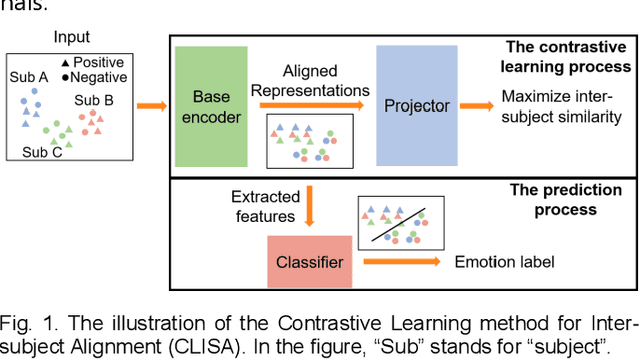
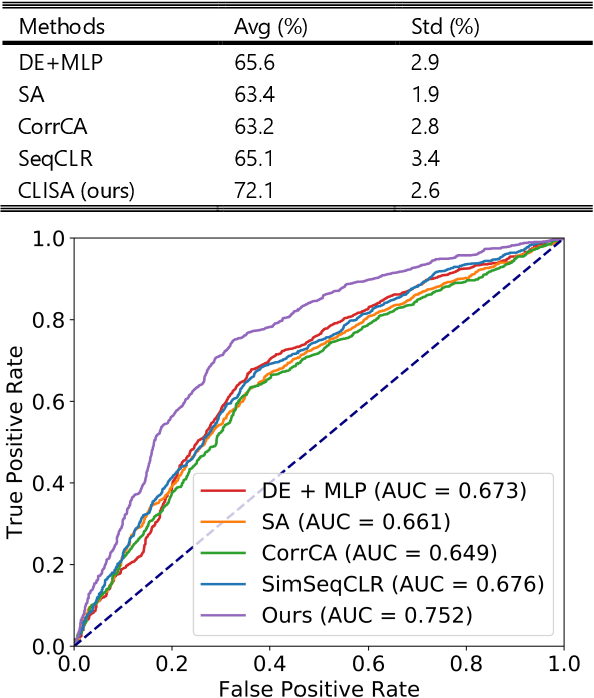

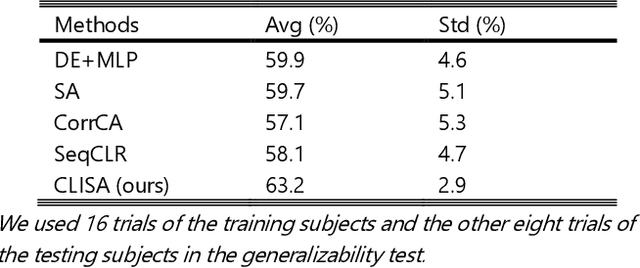
Abstract:Emotion recognition plays a vital role in human-machine interactions and daily healthcare. EEG signals have been reported to be informative and reliable for emotion recognition in recent years. However, the inter-subject variability of emotion-related EEG signals poses a great challenge for the practical use of EEG-based emotion recognition. Inspired by the recent neuroscience studies on inter-subject correlation, we proposed a Contrastive Learning method for Inter-Subject Alignment (CLISA) for reliable cross-subject emotion recognition. Contrastive learning was employed to minimize the inter-subject differences by maximizing the similarity in EEG signals across subjects when they received the same stimuli in contrast to different ones. Specifically, a convolutional neural network with depthwise spatial convolution and temporal convolution layers was applied to learn inter-subject aligned spatiotemporal representations from raw EEG signals. Then the aligned representations were used to extract differential entropy features for emotion classification. The performance of the proposed method was evaluated on our THU-EP dataset with 80 subjects and the publicly available SEED dataset with 15 subjects. Comparable or better cross-subject emotion recognition accuracy (i.e., 72.1% and 47.0% for binary and nine-class classification, respectively, on the THU-EP dataset and 86.3% on the SEED dataset for three-class classification) was achieved as compared to the state-of-the-art methods. The proposed method could be generalized well to unseen emotional stimuli as well. The CLISA method is therefore expected to considerably increase the practicality of EEG-based emotion recognition by operating in a "plug-and-play" manner. Furthermore, the learned spatiotemporal representations by CLISA could provide insights into the neural mechanisms of human emotion processing.
 Add to Chrome
Add to Chrome Add to Firefox
Add to Firefox Add to Edge
Add to Edge